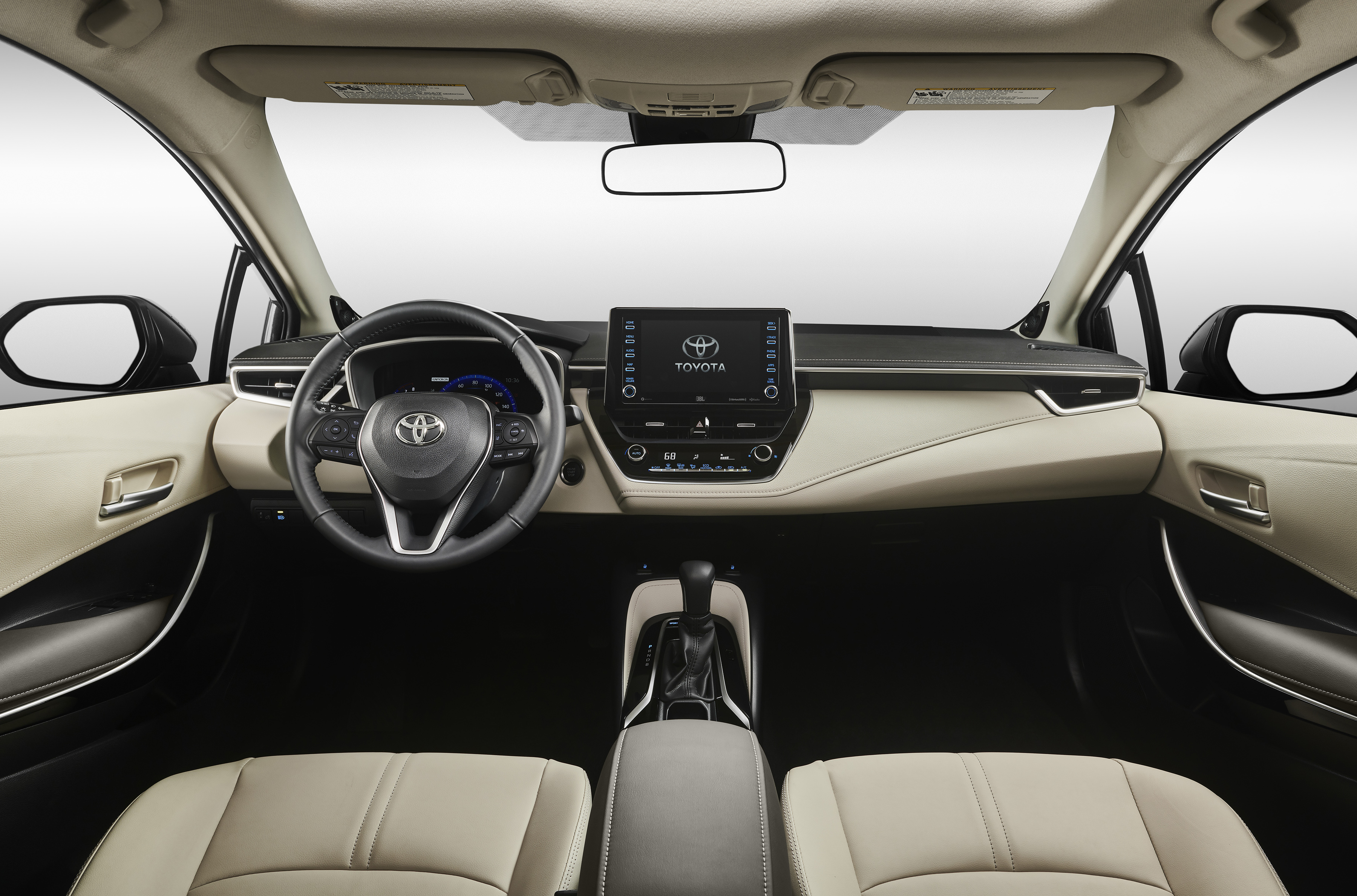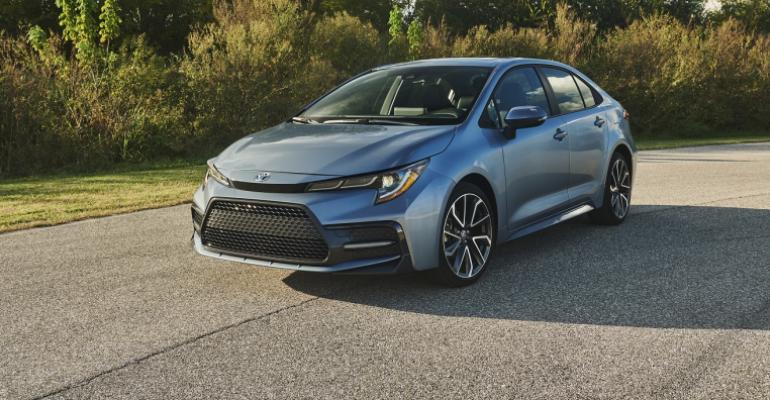CARMEL, CA – The new, 12th-generation Toyota Corolla sedan is revealed here tonight at the same time the covers are pulled in China.
While sales of small sedans still are relatively strong in the world’s most populous country, they have fallen off in the U.S., down 13.8% through October, per Wards Intelligence data, as Americans increasingly opt for CUVs or SUVs. The current Corolla sedan is down 12.7% to 237,717 in that period, while the No.1-selling C-car and the Corolla’s chief rival, the Honda Civic, has fallen 11.7% to 277,486.
Toyota hopes the new ’20 model-year Corolla, riding on an all-new platform and with a new engine, reverses the sector’s downward trend, promising the new sedan is a “highly nimble” and “engaging machine” to drive.
“(We can’t be) as bullish (on a sales target as we were when the current Corolla launched) because the segment has decreased to a point that if you maintain sales year-over-year you’ve done a yeoman’s work,” Jack Hollis, group vice president and general manager-Toyota Div., tells Wards here ahead of the next-gen Corolla’s debut. “(But the Corolla has) one of our highest loyalty rates, so I do feel bullish that we’re going to answer our customers’ desires.”
With some competitors leaving (Ford Focus) or rumored to be leaving (Chevy Cruze) the segment, Hollis believes Toyota can gain market share even if Corolla sales stay flat or decrease.
He’s also hopeful cars, now accounting for roughly 30% of total new light-vehicle sales in the U.S., can regain ground from light trucks.
“I think the segment is finally starting to slow the pace of the decrease,” he says. “There’s cycles in this business. This one’s a lot larger from car to truck, but I think it will go back a little bit. I’m not expecting it to go back to 50/50, that’s for sure, but I do think you’ll see (cars) come back.”
Hollis announces at the media unveil here tonight a new hybrid variant of Corolla will be offered for the first time, debuting at the Los Angeles auto show Nov. 28.
The Corolla’s new TNGA platform, for Toyota New Global Architecture, is shared with other recent small Toyotas, including the hatchback version of the Corolla which launched this past summer in the U.S. and the forthcoming fifth-generation RAV4 midsize CUV.
The Japanese automaker says the platform “imbues the Corolla sedan with greater agility, yet also with its smoothest, quietest ride.”
Features of the new platform include more ultra-high-tensile-strength steel content compared with the outgoing Corolla sedan, better body rigidity thanks to the application of structural adhesives and greater safety due to a new energy-dispersing multi-load-path front structure to reduce deformation of the passenger compartment. Side-collision deformation is said to be lessened via a new squared figure-of-eight ring structure around door beams.
The new 4-door has the same wheelbase length as the outgoing ’19 model – 106.3 ins. (2,700 mm) – but a roughly half-inch wider front track and nearly an inch wider rear track, giving the car a sportier look and more “dynamic” handling, Toyota says.
The sedan’s center of gravity is lowered in part due to an overall shorter height (0.8 ins. [20 mm]) and a 1.4-in. (36-mm) lower hood. Those measures were made possible by lower mounting of the engine compared with the outgoing model.
Interior modifications also play a role in the lower center of gravity, with a driver hip point now 0.98-in. (25-mm) lower and 1.57-in. (40-mm) more rearward. The change also improves driver comfort and the vehicle’s front/rear weight distribution, and is one of several (lower beltline, slim A-pillars, repositioned side-view mirrors) updates that expand outward visibility, Toyota says.
Also said to improve outward visibility is a lower instrument panel, while a longer center armrest boosts comfort.
Moving away from “conventional square” seatbacks for comfort and style reasons, the new Corolla’s XSE and SE grades have headrests that “nestle” into the shoulder area and the XLE and LE grades have a U-shaped-pattern seatback.
The sport-grade XSE and SE seats also are said to have thin, broad shoulder supports overlapping thick side bolsters for “enhanced holding performance.”
While L, LE and XLE Corollas are powered by the current Corolla’s 1.8L 2ZR-FAE engine – albeit updated with unspecified more horsepower and greater fuel efficiency – the SE and XSE have Toyota’s new 2.0L Dynamic Force inline-4 with direct injection from the Corolla Hatch, making 169 hp at 6,600 rpm and 151 lb.-ft. (205 Nm) of torque at 4,800 rpm. All specs are the same as the hatch’s except peak horsepower, which is 168 in the hatch.
Designated M20A-FKS and with a Prius-matching 40% maximum thermal efficiency claim, the 2.0L is more powerful and fuel-efficient than the 1.8L despite being lighter and smaller, Toyota says. To achieve these seemingly contrasting goals, the automaker employs a high compression ratio of 13:1, Toyota’s D-4S direct and port injection system, intelligent variable valve timing with an electric motor on the intake side and intelligent variable valve timing on the exhaust.
A more efficient cooling system, to both maximize engine performance and efficiency and make for faster cabin heating and cooling, also is used in the ’20 Corolla, in the form of a two-discharge port oil pump and a variable cooling system with electric water pump.
Toyota doesn’t provide specs for the 1.8L in the ’20 Corolla, but in the ’19 model the engine churns out 132 hp at 6,000 rpm and 128 lb.-ft. (174 Nm) at 4,400 rpm.
Like the Corolla Hatch, the sedan has the same Dynamic Shift CVT with a fixed first gear for initial acceleration with no lag. It also has 10 simulated steps as well as a sport mode.
The sedan also shares its manual transmission with the hatch, a 6-speed with downshift rev-matching control and standard hill-start assist.
The Corolla switches from a torsion beam to multi-link rear suspension in the ’20 model, improving agility and comfort, Toyota says. The MacPherson front suspension is tweaked, with the automaker promising smoother upward suspension travel when going over bumps thanks to a strut bearing mounted coaxially with the kingpin axis.
The Corolla becomes the third new Toyota to get the automaker’s Safety Sense 2.0 suite (pre-collision system, dynamic radar cruise control, lane-departure alert with steering assist) of advanced driver-assist technologies as standard equipment. CVT models have full-speed DRCC with low-speed follow, as well as lane-centering lane-tracing assist.
Working toward a goal of a “robust, confidence-inspiring stance,” designers gave the Corolla bigger fender flares and curved fender top surfaces, aero-stabilizing fins on SE and XSE models and J-shaped Bi-Beam LED headlamps. Rear lamps also wrap deeply into the fenders and sport grades have smoked lenses.
The Corolla’s interior is described as sensuous and minimal thanks to a decluttered instrument panel, with smaller gaps between buttons and less lettering on switchgear, as well as “character lines that interlock with the door trim.”
High-gloss and matte trim, in the form of piano black and silver accents, decorate the passenger space. The interior is available in blue/black, “Moonstone” light gray and “Macadamia” cream color schemes. For continuity’s sake, the automaker says extra attention was paid to matching grain, color, shape and gloss levels inside the vehicle.

A 7-in. (18-cm) LCD touchscreen at the top of the center stack is standard on L grades and an 8-in. (20-cm) screen is found in LE, XLE, SE and XSE models. The thin-film-transistor multi-information display between gauges is a standard 4.2 ins. (11 cm), but there is an optional 7-in. display available.
Toyota’s Entune 3.0 audio system is standard and, like most new Toyotas, has Apple CarPlay and Amazon Alexa compatibility, as well as Wi-Fi by Verizon, able to connect up to five devices via an in-car 4G LTE hotspot.
The highest grades (XLE and XSE) have an optional 9-speaker, 800-watt JBL audio system with 6.7-in. (17-cm) door subwoofers and Clari-Fi technology that essentially decompresses digital audio signals.
To keep unwanted noise out, Toyota says it extensively uses sound-deadening materials, including Thinsulate, sealants, silencers and foams.
Also for improved passenger comfort, the air-conditioning system is redesigned for better efficiency and effectiveness. For instance, in cold climates dehumidified fresh air automatically is sent to the upper cabin to reduce glass fogging. At the same time, warm cabin air is recirculated in lower areas of the interior, Toyota says.





